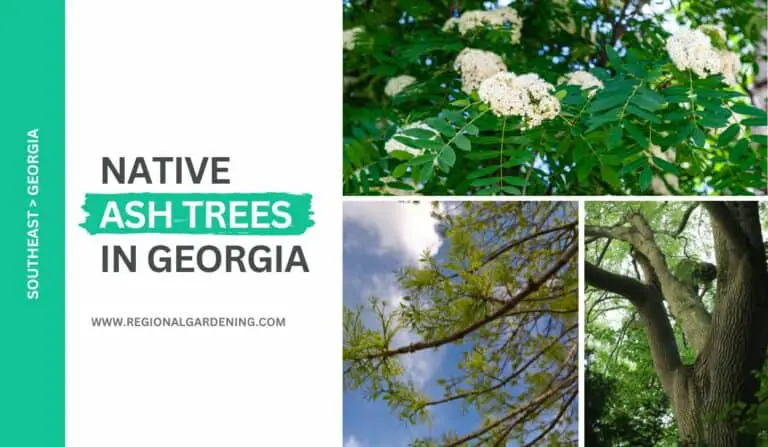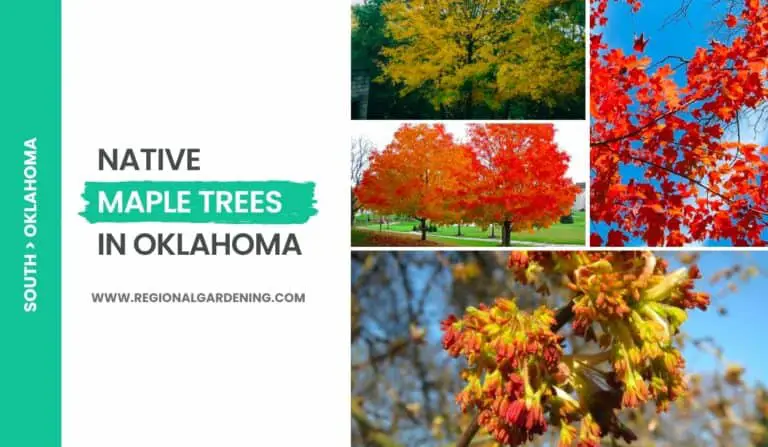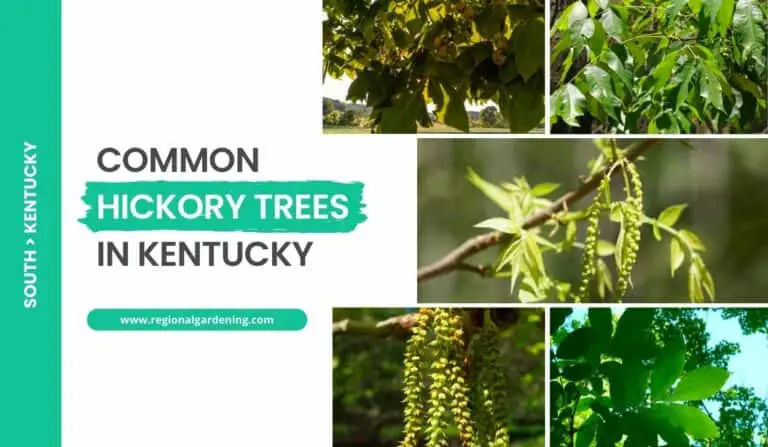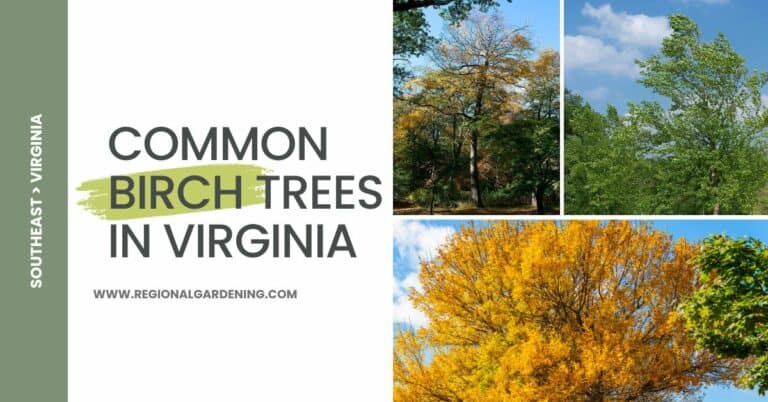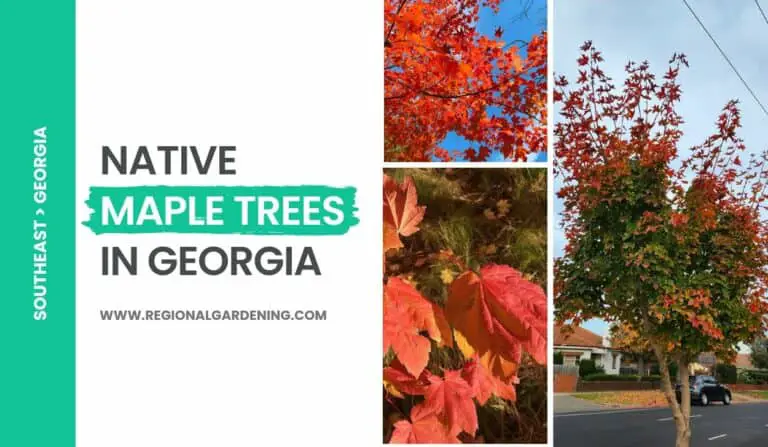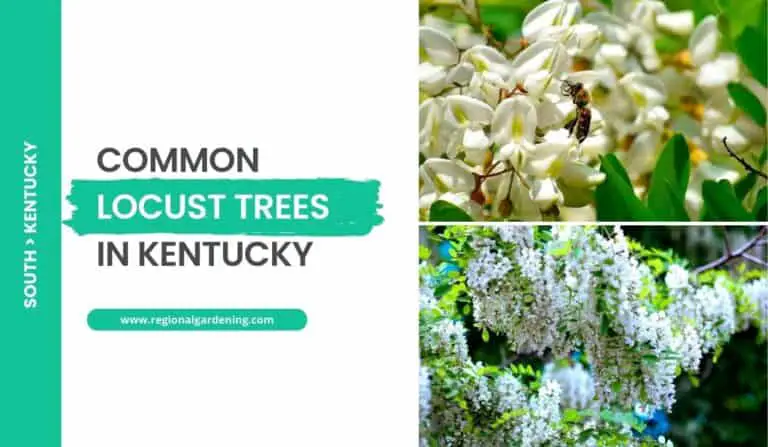6 Common Palm Trees In Virginia (Photos & Care Tips)
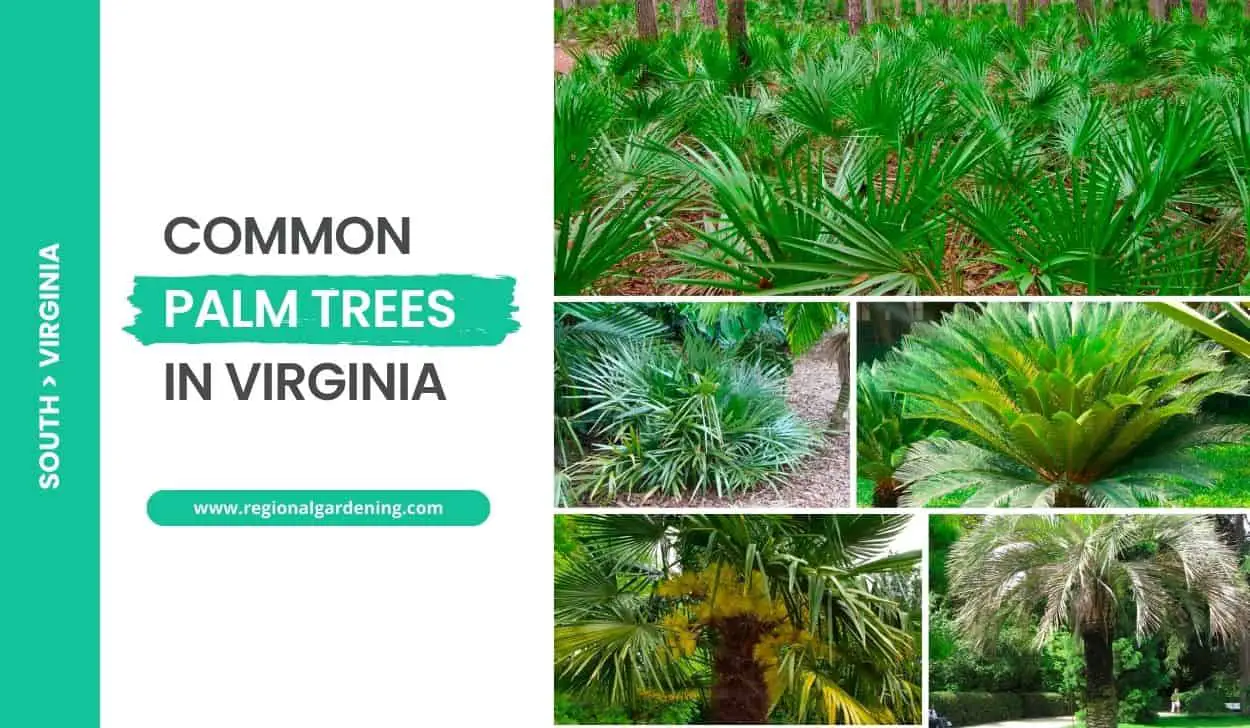
Despite being a non-native species, palm trees create a distinct and eye-catching presence in Virginia’s landscapes from Norfolk to Virginia Beach. These trees, with their tall, slender trunks and graceful fan-like fronds, add a touch of the tropics to this otherwise temperate region.
Whether lining a pool, adorning a patio, or serving as a focal point in a backyard, palm trees in Virginia create a picturesque scene reminiscent of a tropical paradise.
Palm trees in Virginia offer practical benefits in addition to their aesthetic appeal. During the hot summer months, their dense foliage provides much-needed shade, allowing you to relax comfortably outside.
This article will explore the 6 commonly planted ornamental palm trees in Virginia landscapes.
1. Needle Palm
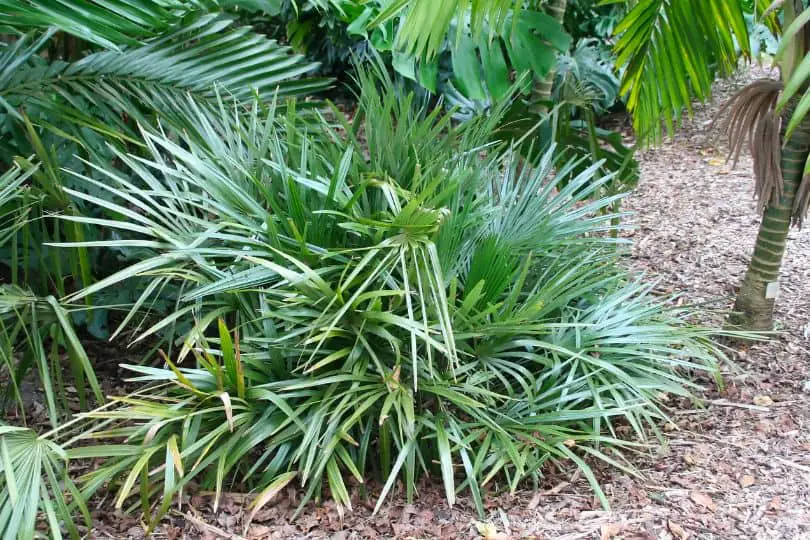
- Scientific Name: Rhapidophyllum hystrix
- Common Name(s): Needle Palm
- Mature Height: 5-12 feet (1.5-3.7 meters)
- Native Region: Southeastern United States
- Flowers: No Flowers.
- Fruit: Small, round, black fruits.
- Uses: Ornamental plant, garden accent, and container plant. Can also provide habitat for birds and wildlife.
The Needle Palm, formally known as Rhapidophyllum hystrix, is one of the commonly found palm trees in Virginia. It is a small to medium-sized tree with a mature height of 5-12 feet. This palm tree is indigenous to the southeastern United States.
The Needle Palm has distinct physical traits that distinguish it from other palms. It has fan-shaped leaves that are severely split, giving them a “needled” look. The dark green leaflets can grow up to 2 feet long, forming a dense, compact crown. The Needle Palm’s trunk is covered in a covering of brown fibers, giving it a rough and harsh appearance.
The Needle Palm can grow in a range of settings and environments in Virginia. It is well-adapted to surviving in cold and hard environments, making it an excellent choice for colder climates such as Virginia. This palm tree is extremely resistant to harsh temperatures, dryness, and even salt spray, making it an excellent choice for coastal settings.
The Needle Palm does not have beautiful flowers, but it does have small, spherical, black fruits. Although few people eat these fruits, they do draw birds and small mammals. The Needle Palm provides significant habitat for birds and other species due to its dense leaves and compact growth pattern.
For needle palm trees in Virginia to thrive, it is critical to choose a spot that receives full to partial sun exposure when planting a Needle Palm. A well-drained soil is also required for this palm tree’s health and growth. Watering is required regularly, especially during dry spells. Mulching around the base of the tree can aid in moisture conservation and temperature regulation.
The Needle Palm is often utilized as an ornamental plant in Virginia landscaping, bringing a tropical flavor to gardens and landscapes. Because of its distinct appearance and ability to survive cooler weather, it is an appealing choice for garden accents and pots. Furthermore, the Needle Palm’s dense foliage and robust trunk can make an aesthetically appealing focal point in any outdoor setting.
2. European Fan Palm
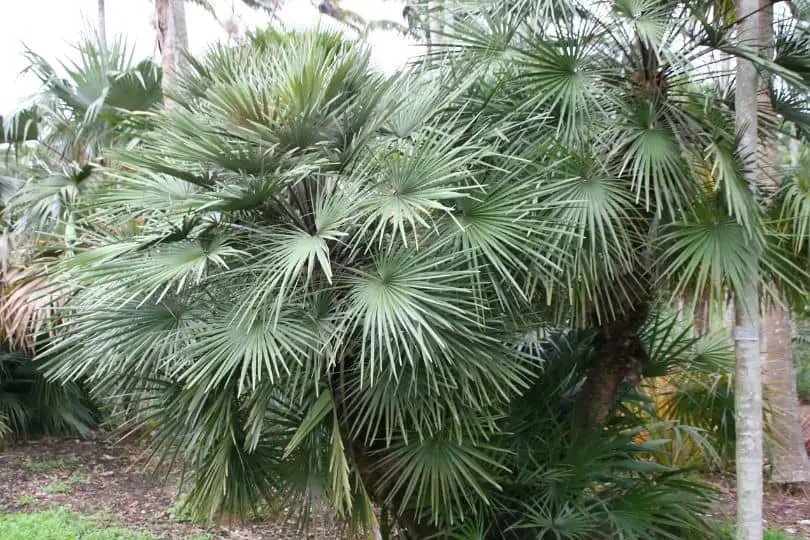
- Scientific Name: Chamaerops humilis
- Common Name(s): European Fan Palm
- Mature Height: 6-15 feet (1.8-4.5 meters)
- Native Region: Mediterranean region in Europe
- Flowers: Yellowish flowers in spring
- Fruit: Small black berries
- Uses: Ornamental trees in gardens and landscapes, can be grown in containers, and the leaves can be used to make thatch roofs and baskets.
The European Fan Palm, Chamaerops humilis, is a small to medium-sized palm tree that is widely seen in Virginia landscapes. It grows to a mature height of 6 to 15 feet (1.8 to 4.5 meters), making it ideal for smaller gardens or containers. This palm tree is native to Europe’s Mediterranean region and thrives in Virginia’s environment.
The fan-shaped, deep green leaves with segmented lobes that distinguish the European Fan Palm are distinctive. The tree’s trunk is clothed in a fibrous, brownish-gray bark that adds to its distinct visual attractiveness. This palm is noted for its toughness and capacity to tolerate cold temperatures, making it ideal for the environment of Virginia.
The European Fan Palm produces little yellowish flowers in the spring, bringing a splash of color to the landscape. These flowers are followed by little black berries, which birds and wildlife appreciate. Humans cannot consume the berries.
It is critical to offer well-drained soil and frequent watering to the European Fan Palm in Virginia landscaping. Once established, this palm tree is drought-tolerant, but it needs regular watering during dry months. It thrives in a variety of soil types and enjoys full sun to slight shade.
Because of its appealing look and compact size, the European Fan Palm is often utilized as an ornamental tree in gardens and landscapes. It is frequently utilized as a focal point or to create a tropical feel. This palm may also be grown in pots, making it a versatile option for smaller outdoor spaces like patios. The European Fan Palm’s leaves can also be used to build thatch roofs and baskets, which adds a utilitarian side to its usage.
3. Sago Palm
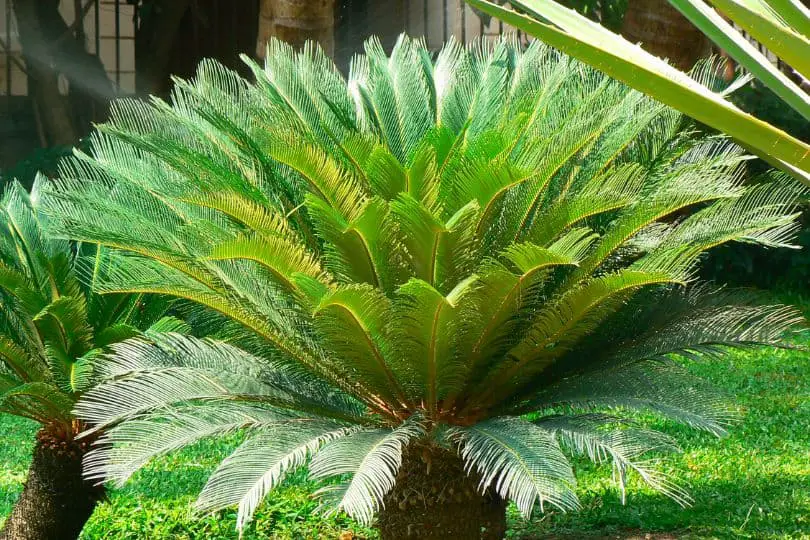
- Scientific Name: Cycas revoluta
- Common Name(s): Sago Palm
- Mature Height: 6-10 feet (1.8-3 meters)
- Native Region: Japan, Southern China
- Flowers: No Flowers
- Uses: Ornamental plants used in landscapes and gardens
The Sago Palm, or Cycas revoluta, is a common decorative plant in Virginia landscaping. It is not a palm tree, but a cycad, a group of ancient plants that have existed for millions of years. The mature height of the Sago Palm is 6-10 feet (1.8-3 meters) and it has a distinct and appealing appearance.
The foliage arrangement of the Sago Palm is distinctive and fascinating. It features fluffy, deep green leaves that sprout from a central trunk. These shiny, rigid leaves add an intriguing texture to the environment. The bark on the trunk is tough and brownish-brown in color. The Sago Palm’s luxuriant foliage and textured trunk make it a visually appealing addition to any garden or landscape.
The Sago Palm, which is native to Japan and Southern China, thrives in Virginia’s environment. It is a tough plant that can withstand a wide variety of temperatures and is resistant to a wide range of pests and diseases. It prefers soil with good drainage and moderate moisture levels. In terms of sunshine, the Sago Palm may grow in full sun to moderate shade, making it adaptable to a variety of landscape settings.
The Sago Palm, unlike real palms, does not produce showy blossoms. Instead, it forms cone-shaped structures with both male and female reproductive components. These cones are often reddish-brown and can serve as an eye-catching focal point for the plant. In addition, the Sago Palm produces small, spherical, orange fruits that are hazardous to people and dogs if consumed.
Aside from its decorative significance, the Sago Palm offers a variety of purposes. It is frequently used as a focal point or as a container plant in landscapes and gardens. It can also be grown as a houseplant indoors. However, all components of the Sago Palm, including the leaves and seeds, are toxic if swallowed, so use caution when growing it in areas where pets or children may come into touch with it.
4. Windmill Palm
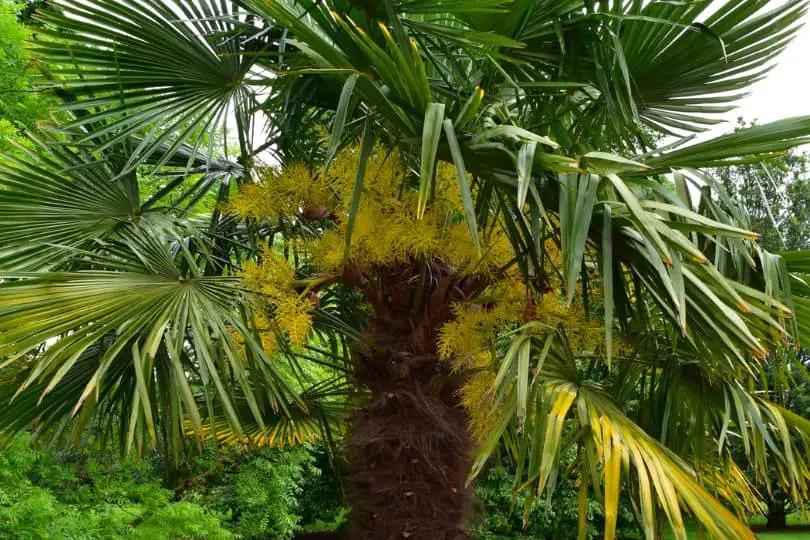
- Scientific Name: Trachycarpus fortunei
- Common Name(s): Windmill Palm
- Mature Height: 20-40 feet (6-12 meters)
- Native Region: China
- Flowers: Small yellow flowers in large clusters
- Fruit: Small black berries
- Uses: Ornamental, landscaping, palm oil production
The Windmill Palm (Trachycarpus fortunei) is one of the prominent palm trees in Virginia landscapes. It grows slowly and can reach a mature height of 20-40 feet (6-12 meters). This palm tree, which is native to China, is well-adapted to the region’s climate and can withstand freezing temperatures better than other palm species.
The Windmill Palm features huge, fan-shaped leaves that develop in a circular manner that resembles windmill blades, hence its popular name. A short, brownish trunk with a fibrous feel supports the bright green leaves. The trunk’s bark is tough and frequently covered in a covering of brown or gray hairs.
The Windmill Palm blooms in enormous clusters of tiny yellow flowers in the spring. The blossoms are unobtrusive but lend a lovely touch to the tree. Small black berries appear after flowering, adding interest to the tree’s appearance. Birds and wildlife are drawn to these berries.
While caring for windmill palm trees in Virginia, it is critical to choose well-draining soil and offer ample sunlight. This palm tree prefers partial shade over full sun. Watering is required regularly, especially during dry seasons, although excessive moisture can cause root rot.
The Windmill Palm is frequently used as an attractive plant in gardens and landscapes. Its distinct appearance and resistance to frigid conditions make it a popular choice among homeowners.
Furthermore, the huge leaves of the tree provide shade and shelter for lesser plants and undergrowth. Some homeowners also use the Windmill Palm to produce palm oil because the tree’s fruit contains oil that can be harvested and used in a variety of industries.
5. Pindo Palm
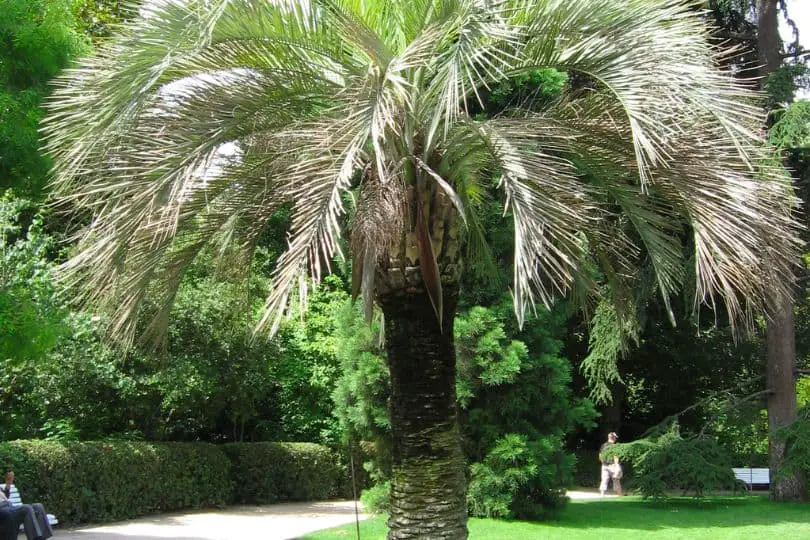
- Scientific Name: Butia capitata
- Common Name(s): Pindo Palm, Jelly Palm
- Mature Height: 15-20 feet (4.5-6 meters)
- Native Region: South America
- Flowers: Yellow to beige flowers in large clusters
- Fruit: Orange to yellow edible fruit, resembling small coconuts
- Uses: Ornamental tree, fruit production, palm wine production.
The Pindo Palm, technically known as Butia capitata, is a palm tree species found throughout Virginia. This palm tree matures at a height of 15 to 20 feet (4.5 to 6 meters), making it a modest palm tree in comparison to other species. It is native to South America, specifically Brazil, Uruguay, and Argentina.
Long, arching fronds with feather-like leaflets give the Pindo Palm a lovely appearance. The bluish-green leaves grow in a dense, spherical crown on a sturdy stem. The bark on the trunk is often fibrous and brownish-gray. The Pindo Palm is recognized for its cold tolerance and may be found in USDA hardiness zones 7b to 11.
The Pindo Palm produces huge clusters of fragrant yellow-to-beige blooms that hang down from the crown in the spring. Bees and other pollinators are drawn to these flowers. The tree also develops small, spherical, orange-to-yellow fruits that resemble little coconuts from late summer to early fall. The fruit is edible and tastes sweet and tart. It can be eaten raw or cooked into jams, jellies, and even fermented palm wine.
Because of its appealing look and capacity to survive a wide range of soil conditions, the Pindo Palm is frequently utilized as an ornamental tree in Virginia landscaping. It’s typically grown as a specimen tree near pools or in tropical-themed gardens. Because of its modest stature, it is ideal for small yards or container gardening. To thrive, the Pindo Palm requires full light and well-drained soil. Once established, it is a drought-tolerant tree that benefits from regular watering during dry years.
6. Saw Palmetto Palm
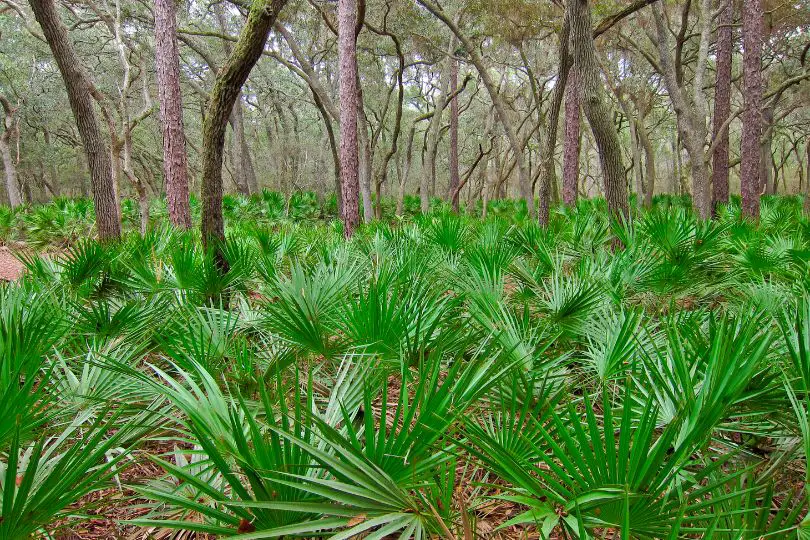
- Scientific Name: Serenoa repens
- Common Name(s): Saw Palmetto Palm
- Mature Height: 6-10 feet (1.8-3 meters)
- Native Region: Southeastern United States
- Flowers: White or pale yellow flowers in small clusters
- Fruit: Dark purple to black berries
- Uses: Medicinal value, landscaping, wildlife habitat
Serenoa repens, or Saw Palmetto Palm is a tiny palm tree that is widely seen in Virginia landscapes. It matures to a height of 6 to 10 feet (1.8 to 3 meters), making it ideal for modest outdoor settings or container gardening.
The southeastern United States, including areas of Virginia, is home to this palm tree. It is well adapted to the environment of the region and can flourish in sandy or well-drained soils. The fan-shaped leaves of the Saw Palmetto Palm can grow up to 3 feet (0.9 meters) long, forming a dense evergreen canopy. Its stem is frequently prostrate or partially subterranean, lending it a distinct appearance.
Flowers are produced by the Saw Palmetto Palm, however, they are small and inconspicuous. White or pale yellow blooms grow in tiny clusters. The tree produces dark purple to black berries after flowering, which are a vital food source for wildlife, including birds and mammals.
The medical benefit of the Saw Palmetto Palm is one of its most notable applications. The berries of this palm tree contain nutrients and chemicals that have been utilized in traditional medicine for ages. They are especially well-known for their possible benefits in promoting prostate health. Furthermore, the Saw Palmetto Palm is frequently utilized as an understory plant or ground cover in landscaping. Its dense foliage and low-growing habit make it an appealing choice for creating natural borders or adding texture to garden beds.
When caring for a Saw Palmetto Palm in your garden, make sure it has well-drained, sandy soil and enough sunlight. Once planted, this tree is drought-tolerant, but constant watering is essential throughout the establishment stage. Pruning is not usually required, although you may want to remove any dead or damaged fronds for aesthetic reasons.
Similar Articles
- 14 Common Native Oak Trees In Virginia
- 6 Purple Trees In Virginia
- 4 Common Native Hickory Trees In Virginia
- 5 Common Native Maple Trees In Virginia
- 3 Common Cedar Trees In Virginia
- 3 Common Birch Trees In Virginia
- 8 Native Pine Trees In Virginia
- 9 Common Nut Trees In Virginia
- 3 Native Elm Trees In Virginia
- 2 Native Ash Trees In Virginia
- 7 Native Evergreen Trees In Virginia
- 8 Native Flowering Trees In Virginia
- Common Locust Trees In Virginia
- 6 Pink Flowering Trees In Virginia
Common Palm Trees In Virginia – Sources
By only using reliable sources, the Regional Gardening team ensures the validity of the data presented in our articles. These sources include peer-reviewed journals published by esteemed universities and scientific research institutions.


